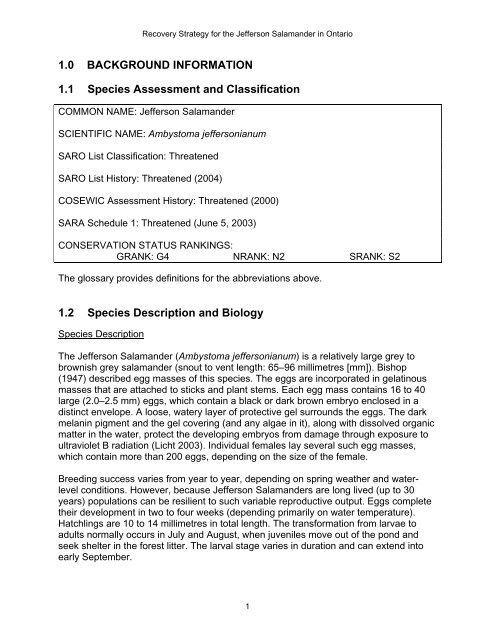Jefferson Salamander - Amphibian Specialist Group
Jefferson Salamander - Amphibian Specialist Group
Jefferson Salamander - Amphibian Specialist Group
You also want an ePaper? Increase the reach of your titles
YUMPU automatically turns print PDFs into web optimized ePapers that Google loves.
Recovery Strategy for the <strong>Jefferson</strong> <strong>Salamander</strong> in Ontario1.0 BACKGROUND INFORMATION1.1 Species Assessment and ClassificationCOMMON NAME: <strong>Jefferson</strong> <strong>Salamander</strong>SCIENTIFIC NAME: Ambystoma jeffersonianumSARO List Classification: ThreatenedSARO List History: Threatened (2004)COSEWIC Assessment History: Threatened (2000)SARA Schedule 1: Threatened (June 5, 2003)CONSERVATION STATUS RANKINGS:GRANK: G4 NRANK: N2 SRANK: S2The glossary provides definitions for the abbreviations above.1.2 Species Description and BiologySpecies DescriptionThe <strong>Jefferson</strong> <strong>Salamander</strong> (Ambystoma jeffersonianum) is a relatively large grey tobrownish grey salamander (snout to vent length: 65–96 millimetres [mm]). Bishop(1947) described egg masses of this species. The eggs are incorporated in gelatinousmasses that are attached to sticks and plant stems. Each egg mass contains 16 to 40large (2.0–2.5 mm) eggs, which contain a black or dark brown embryo enclosed in adistinct envelope. A loose, watery layer of protective gel surrounds the eggs. The darkmelanin pigment and the gel covering (and any algae in it), along with dissolved organicmatter in the water, protect the developing embryos from damage through exposure toultraviolet B radiation (Licht 2003). Individual females lay several such egg masses,which contain more than 200 eggs, depending on the size of the female.Breeding success varies from year to year, depending on spring weather and waterlevelconditions. However, because <strong>Jefferson</strong> <strong>Salamander</strong>s are long lived (up to 30years) populations can be resilient to such variable reproductive output. Eggs completetheir development in two to four weeks (depending primarily on water temperature).Hatchlings are 10 to 14 millimetres in total length. The transformation from larvae toadults normally occurs in July and August, when juveniles move out of the pond andseek shelter in the forest litter. The larval stage varies in duration and can extend intoearly September.1
















